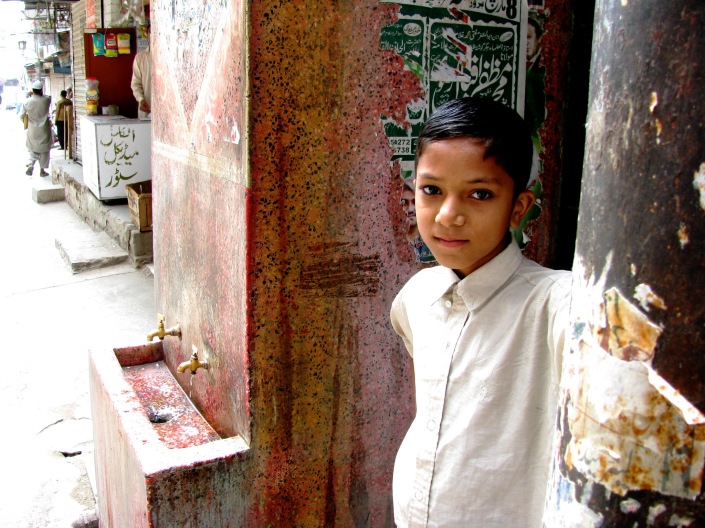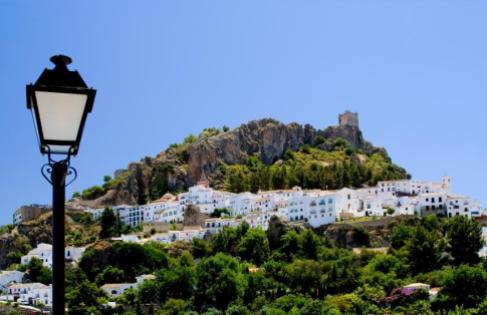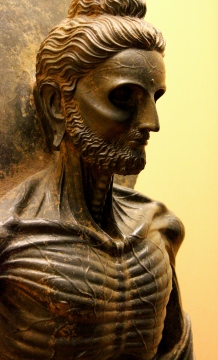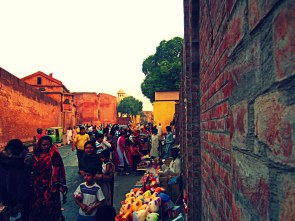History
On heritage
“The ground on which we stand is sacred ground. It is the dust and blood of our ancestors.” – Chief Plenty Coups, Crow
Whenever I visit a new city, the first thing I like to do is pay my respects to her oldest monument.
Like the towering 12th century St. Stephen’s Cathedral in Vienna. The ancient, sprawling Palatine Hill in Rome. A ruined Moorish lookout tower in the village of Zahara de la Sierra in Andalusia. The 1000-year old dragon tree on the island of Tenerife.
Or, when I’m back in my hometown Lahore, the 10th century shrine of Ali Hajveri, the city’s patron saint and one of South Asia’s most celebrated sufis.
It’s kind of like how you make it a point to greet elders first at a family gathering, or how you always pop in to say salaam to Aunty Uncle or Daadi Daada when calling at a friend’s.
Why is it considered proper to do this?
Because age, when tempered by experience and good sense, is wisdom. And wisdom commands respect.
Our parents, grandparents and great-grandparents are the pillars of our community, our connection with the past. And much of who we are – our tastes, our temperament, the intonation of our voice, that dimple on the chin – we owe directly to them.
So it is with cultural heritage.
It’s an intangible thing, our relationship with heritage; a deep, spiritual connection that can’t be quantified, only experienced.
Like the feeling of awe you get when entering a breathtaking mosque or cathedral, in all its glazed tiled, stained glass, soaring glory. The wonder of walking through a mind-blowingly modern city like 1st century Pompeii. The peace of contemplating the Fasting Buddha at the Lahore Museum.
Or the tingling horror of seeing before you the torture instruments used during the Spanish Inquisition.
Heritage speaks to us. It moves us, because it’s an intrinsic part of ourselves. It tells us who we are, where we come from and what we’ve done – for better or for worse. Heritage gives us identity.
So when human beings destroy cultural heritage – whether purposefully, as invaders and extremists have done throughout the ages, or out of sheer stupidity and greed, as often happens in Pakistan – they aren’t just blowing up bricks and stones, or splashing white paint on a delicately frescoed tomb.
They’re erasing the identity of a society. By blotting out pieces of the past, they leave us a fragmented, rootless future. They leave us without a story.
Years and years ago, there used to exist a temple here. A sculpture. A library. A place of beauty, intelligence and culture.
But you will never know it. You will never wander its ruined pathways, finger its mossy stones, or feel that inexplicable sense of belonging, the warm pride of knowing, “My ancestors built this. And I am a part of this mysterious, timeless story.”
What will you build on now? Where will you find inspiration? How will you write the next chapter of the story?
I often feel a strong sense of déjà vu when visiting old places. There is power there, the coming together of a thousand wills, of history being constructed, brick by brick and thought by thought. Being in these places, you begin to see things differently; you begin to understand why people look the way they do, why they speak in a certain way, why they create certain things – why they are who they are, for better and for worse.
It’s like seeing old photographs of your grandparents and great-grandparents and starting at the resemblance: “That looks just like me!”
You may not like what you see, but you can’t ignore it’s there.
Cultural heritage is part of our DNA. We have a right to claim it, to cherish it, and interpret it the way we choose.
And we have a duty to preserve it, so our children and their children may also have a sacred place to call their own.
So they may also draw on that ancient repository of stones and memories, be reminded of where their ancestors went wrong – and where they went beautifully right.
So they may continue writing the story.
Old Lahore
Eid Mubarik, dear readers, from me and my beautiful city of Lahore! Enjoy these photos of Old Lahore, taken over the years on trips back home, as the city changes from daytime stateliness to magical after-dark chaos.
Click here to view the complete set of photos on Flickr.
Gandhara Sculpture at the Lahore Museum
This summer, I volunteered at the beautiful Lahore Museum to create a brochure for their Gandhara Buddhist Art collection. The Gandhara Gallery, one of the Museum’s most spectacular, draws thousands of local and foreign visitors every year, yet there was no visitor-friendly literature about it that could be used for educational purposes, or as an informative souvenir.





Click here to view the complete gallery of my Gandhara Sculpture photos on Flickr.
The brochure comprises of 5 double-sided pages, each page 10″ x 5″, with the renowned Fasting Siddhartha on the cover and Visitor Information at the back. I did the photography and text as well as brochure design. For the Lahoris, hopefully you’ll be able to get a nice, glossy hard copy of the brochure at the Museum soon!


Is there a Pakistan to go back to?
Published in The Express Tribune Blog, January 20th, 2011
Last week, my husband and I finally booked our return tickets to Pakistan. It was a proud moment, a happy moment, not only because we had been saving to buy them for months, but because we had not been home in nearly two years.
Two years! It seemed like a lifetime. We had missed much: babies, engagements, weddings, new additions to the family and the passing of old, new restaurants and cafés, new TV channels, even the opening of Lahore’s first Go-Karting park. I could hardly contain my excitement.
Yet, my excitement was tainted by a very strange and disquieting thought – was there even a Pakistan to go back to?
My family and friends would be there, yes, and the house I grew up in, and my high school, and the neighborhood park, and the grocery store where my mother did the monthly shopping, and our favorite ice cream spot…
But what of the country? And I’m not talking about the poverty, and corruption, and crippling natural disasters – I’m talking about a place more sinister, much more frightening…
A place where two teenage boys can be beaten to death by a mob for a crime they didn’t commit, with passersby recording videos of the horrific scene on their cell phones…
A place where a woman can be sentenced to hang for something as equivocal as “blasphemy”…
A place where a governor can be assassinated because he defended the victim of an unjust law, and his killer hailed as a “hero” by religious extremists and educated lawyers alike…
This is not the Pakistan I know. This is not the Pakistan I grew up loving. This bigoted, bloodthirsty country is just as alien to me as it is to you.
The Pakistan I know was warm, bustling and infectious, like a big hug, a loud laugh – like chutney, bright and pungent, or sweet and tangy, like Anwar Ratol mangoes. It was generous. It was kind. It was the sort of place where a stranger would offer you his bed and himself sleep on the floor if you were a guest at his house; a place where every man, woman or child was assured a spot to rest and a plate of food at the local Sufi shrine. A place where leftovers were never tossed in the garbage, always given away, where tea flowed liked water and where a poor man could be a shoe-shiner one day, a balloon-seller the second, and a windshield-wiper the third, but there was always some work to do, some spontaneous job to be had, and so, he got by.

My Pakistan was a variegated puzzle – it was a middle-aged shopkeeper in shalwar kameez riding to work on his bicycle, a 10-year old boy selling roses at the curbside, a high-heeled woman with a transparent pink dupatta over her head tip-tapping to college, with a lanky, slick-haired, lovelorn teenager trailing behind her.
A Michael Jackson-lookalike doing pelvic thrusts at the traffic signals for five rupees, a drag queen chasing a group of truant schoolboys in khaki pants and white button-down shirts. Dimpled women with bangled arms and bulging handbags haggling with cloth vendors, jean-clad girls smoking sheesha at a sidewalk café, and serene old men in white prayer caps emerging from the neighborhood mosque, falling in step with the endless crowd as the minarets gleamed above with the last rays of the sun in the dusty orange Lahore sky.

My parents were practicing Muslims, and religion was always an important part of my life. Like most Pakistani children, my sister and I learnt our obligatory Arabic prayers at the age of 7; I kept my first Ramadan fast when I was 10, bolting out of bed before dawn for a sublime sehri of parathas, spicy omelettes, and jalebi soaked in milk. By the time I was 13, I had read the Holy Qur’an twice over in Arabic, with Marmduke Pickthall’s beautifully gilded English translation.

But beyond that – beyond and before the ritual, or maddhab, as they say in Sufism, came the deen, the heart, the spirit of religion, which my parents instilled in us almost vehemently, and which to me was the true message of Islam – compassion, honesty, dignity and respect for our fellow human beings, and for every living creature on the planet.
So, while we as Pakistanis had our differences, and practiced our faith with varying tenor – some were more “conservative” than others, some more “liberal”, some women did hijab while others didn’t, some never touched alcohol while others were “social drinkers” – we were all Muslim, and nobody had the right or authority to judge the other, no red-bearded cleric or ranting mullah. There were no Taliban or mullahs back then; if they existed, we never saw them. Not on TV, not in the newspapers, not on the streets, in posters or banners or fearsome processions.
It wasn’t a perfect society – far from it. Inequality and abuses were rampant, and daily life for a poor person could be unbearable. But they were the kind of problems that every young, developing, post-colonial nation faced, and the worst thing that could happen to you when you stepped out of the house was a petty mugging or a road accident, not a suicide blast. It was chaotic, but it was sane.
Then 9/11 happened, and society as my generation knew it began to unravel.
It started as a reaction to the U.S.-led invasions of Afghanistan and Iraq, and the “clandestine” war in Pakistan – a reaction shared by Pakistanis across the social spectrum. But somewhere along the way, the anger and grief mutated into a suicidal monster of hatred, robed in religion and rooted in General Zia’s pseudo-Islamic dictatorship of the 1980’s and the U.S.-funded Afghan jihad. Pakistan was engulfed by a frenzy, an unspeakable frustration, not only at the neighboring war that had expanded into its heartland, but at everything that was wrong with the country itself. And, like the hysteria that fueled the Crusades or the 17th-cenutry Salem witch-hunt, religion was the most convenient metaphor.
I don’t claim to understand it all, or be able to explain it. But what I do know is that, alongside the two purported targets of the “War on Terror”, there is no greater victim of 9/11 than America’s indispensable, ever-“loyal” ally and doormat, Pakistan itself.
Maybe I’m romanticizing a little. Maybe I’m being over-nostalgic about the past, and the Pakistan of my childhood. But that’s the only way I can retain some affection for my country, the only way I can sustain the desire to go back and live there – if I know and remember in my heart, that it has been better. That it was not always like this. That it was once rich, multifaceted, beautiful, tolerant, sane – and can be again.

Lahore’s Old City
As this is my first post, it seems fitting to dedicate it to Lahore, my beautiful hometown. I haven’t lived there for 3 years now, so I’m aware that much of my nostalgia is tinted. But what does it matter? Lahore will hold endless fascination and mystery for me, if only in my imagination. This is a “brief” history of Lahore’s inner city, the “Androon Shehr” in Urdu, that I wrote as part of my thesis at college, with my cousin and constant companion Sana. Here is an excerpt, minus the footnotes! Any additional lore, fact or fiction about Lahore is welcome :) You may also want to read Chowk: Musings at a Crossroads.
_________________________________________________________________________________________
“Lahore of blissful waters, be praised
The goal of old and young, Lahore
I do not think that in the seven climes
A place so lustrous exists, as Lahore.”
– Talib-i Amuli, Ghaznavid poet
Hindu legend has it that, nearly three millennia ago, Loh, one of the sons of the god Rama, hero-king of the epic “Ramayana”, founded a city on the banks of the river Ravi. He called the city Loh-Awar – “The Fort of Loh” in Sanskrit. Situated on a naturally elevated alluvial plain at the gateway between the mountains of Kashmir and waters of the Indus, Loh could not have chosen a more scenic or strategic location for his city. Today, we know Loh-Awar by one of the numerous variants of its name that survived: Lahore.
The original site of Lahore, believed to have existed somewhere in the foundations of the Lahore Fort, is now found only in myth and imagination. However, historical evidence suggests that the “core” of the city, what is known colloquially as the Androon Shehr, assumed its present shape and form in the aftermath of the Ghaznavid invasion in the 11th century. Hitherto a mysteriously abandoned Hindu principality, the city underwent a veritable transformation at the able hands of Malik Ayaz, governor of Lahore under Mahmud of Ghazna. It is said that Malik Ayaz built up the walls and gates of the city in one miraculous night; whether or not that is true, Lahore, the capital of Mahmud’s Indian provinces, soon grew to rival the city of Ghazna itself as a centre of wealth, learning and culture.
Lahore suffered many reversals of fortune in the ensuing centuries, the inevitable target of countless invaders, plunderers and would-be kings – from the Ghauris to the Mongols, Taimur the Lame to Bahlul Lodhi – owing this fate both to its geographical location and to the stories of its splendour. However, it was not until 1526, when a certain Taimurid prince from Ferghana decided too to try his luck in the plains of the Punjab, that Lahore regained the status and security it had enjoyed in Ghaznavid times. That young prince was Babar, the first Mughal emperor, and his dynasty, firmly anchored in its North Indian strongholds, had come to sta y.
Thus the city of Lahore, together with Delhi and Agra, witnessed the apogee of its career under Mughal patronage. Merchants, scholars, musicians, lovers, travellers from both ends of Eurasia, thronged its narrow streets; Eastern and Western poets alike eulogized the city for its “palaces, domes and gilded minarets”, for the “enchantment” locked within the burnt-bricks of its miraculous walls. In 1584, the Emperor Akbar shifted his royal residence to Lahore, renovating the Fort, constructing nine guzars (residential quarters) within the city, and rebuilding its walls and gates. His son Jahangir, likewise, continued the legacy of the sponsorship of arts and architecture in the city of his birth; English visitors to Lahore, especially frequent since Jahangir granted trading rights to the East India Company in the early 17th century, described it as “a goodly great city, one of the fairest and most ancient of India, exceeding Constantinople itself in greatness”. But it is Jahangir’s son, Shah Jahan, who earned for himself the repute of greatest of Mughal emperors, at least in terms of wealth and architectural opulence. Under Shah Jahan, Lahore glittered and flourished like never before: “a handsome and well-ordered city”, “crammed with foreigners and rich merchants” and “abundant in provisions”, in the words of Niccolo Manucci, an Italian physician serving at the Lahore court in Shah Jahan’s reign. The Wazir Khan Mosque, Shish Mahal (“Palace of Mirrors”, within the Lahore Fort) and Shahi Hamam (“Royal Bath”) in the Walled City, as well as the Shalimar Gardens in the suburbs, are but a few remaining testaments of the prosperity of the age, while the Taj Mahal in Agra has acquired iconic status.
Yet, already in Shah Jahan’s lifetime, Mughal coffers had begun to shrink, and the reign of his younger son Aurangzeb, last of the great Mughal emperors and builder of the Badshahi Mosque, was plagued with all the uncertainty and instability of a dynasty running the final pages of its history. With the death of Aurangzeb, Lahore, like the remaining parts of the Indian subcontinent still outside the control of British traders and self-styled governors, fell victim to the cruel vicissitudes of politics. The relentless raiding of the Afghan Ahmad Shah Durrani, and later Shah Zaman, and their furious battles with the Sikhs over the sovereignty of Lahore left the city permanently scarred. When the Sikh forces, led by Ranjit Singh, ultimately took power in 1797, they inherited a desolate township with crumbling walls, which they proceeded to loot and destroy, so that in 1809, an English officer described Lahore as “a melancholy picture of fallen splendour, of which now only the ruins are visible.”
But Lahore saw the beginning of the most damaging phase of its history in 1849, when the British purchased the province of Punjab from the incumbent Sikh Maharaja. The colonial authorities did not loot or plunder the Inner City as previous invaders had; they Orientalised it. While they did engage in major renovation projects in the Inner City, repairing portions of the Lahore Fort, Badshahi Mosque and other buildings destroyed by the Sikhs, their efforts were centred upon the development of the Civil Lines and Cantonments, which lay beyond the perimeter of the Walls. Suddenly, the Inner City became synonymous with the “Old City”. Invisible barriers were erected between “native” space, symbolized by the crowded, “quaint” streets of the Androon Shehr, and the manicured, tree-lined “colonially produced” space without– the origins of dualism, the modern-traditional dichotomy that prevails in postcolonial cities to this day.
Numerous crafts and trades, associated with and sustained by the demands of a royal court (Ghaznavid, Mughal and Sikh), met their inevitable demise with the British interlude – for example, the manufacture of elaborately wrought weaponry. Other court-related skills, such as miniature painting and fresco-work, were stripped of their former utility and relegated to the status of antiquated “arts”, fit to be practiced in Art Schools alone. Yet others, such as gold embroidery, silk-weaving and brass- and copper-smithing, continued to persist, though they catered to a diminishing “inside” population, relative to the rapid settlement of “outside” areas by colonials and indigenous nouveau riche. At the same time, the British initiated an irreversible process of change within the Androon Shehr, especially through the act of removing much of the old walls of the city as a precautionary measure against urban revolt, which became a genuine threat in the years following the Mutiny, or War of Independence, in 1857.
On the eve of decolonization, the Androon Shehr was still considered a prestigious, if not an affluent area, the cosmopolitan home of Lahore’s old, well-established families, of upper-class literati, bourgeois merchants and vagabonds alike. But Partition violence, concentrated in the border cities of the Radcliffe Award, devastated the fabric of the Androon Shehr’s society on an unparalleled scale; “The Walled City was shaken to its foundations”. The inhabitants of the Shehr, riled by communal hatred, wreaked havoc upon their own city – the gates were vandalized, bazaars were burnt, and entire neighbourhoods razed to the ground. Depopulation of the religious enclaves, coupled with the waves of migrants from across the border, turned Lahore into a rootless city of ruffians and refugees. From this massive convulsion, the Androon Shehr never truly recovered. It was the point of no return.
It was also the point of new beginnings. In the freshly conceived country of Pakistan, Lahore retained its age-old position as capital of the Punjab, yet the intensive redevelopment work that followed, under the auspices of the Lahore Improvement Trust (LIT), did not aim to “preserve” what was left behind. It aimed to remake. The debris was levelled clean by bulldozers, the narrow streets giving way to large thoroughfares and new markets, with little or no consideration to the surrounding architecture. Yet, in what seems an ironic or perhaps expected sequel to colonial activities, Lahore resumed to expand outwards, with the LIT concentrating its construction efforts upon areas such as the Civil Lines, and the new suburban communities of Model Town, Gulberg, G.O.R., Mayo Gardens and so on.
Meanwhile, the Androon Shehr was left to its own devices, and change was inevitable, though difficult to define. The Shehr was not impervious to the contemporary forms of modernization enveloping the surrounding city, yet, up till 1979, more than 80% of its built stock still comprised of Mughal structures, and most of the Lahore Development Authority’s public and municipal development programs continued to focus on the newer parts of the city.
Today, the Androon Shehr, as a physical space, is a mass of old, beautiful, rotting buildings and dusty, twisting streets, with choked gutters, unreliable water supply and precarious housing – home to “over a quarter of a million people, the largest concentration of urban poor in the country”. The government as well as academia profess to take keen interest in “arresting the decay of the city to preserve the nation’s heritage”, but the superficiality of their claims is borne out by observing the ground reality in the Shehr itself. The prominent monuments within the Shehr, mainly the Fort, tombs and older mosques, are repeatedly made the targets of much-advertised “historical conservation” and tourism campaigns, while the inhabitants of the City themselves, their lives and grievances, are conveniently overlooked in the media and other popular discourse.
It seems, in another ironic sequel to colonial Orientalism, that, for the people living “outside”, the Walled City exists solely for its historical value, a “suspended” site where only “traditional” time and place must be celebrated; the inexorable transformations taking place within the Shehr are altogether ignored. As it happens, however, the reality of the Androon Shehr differs sharply from the intentions to propel it as “a museum and relic of past glory”.








































